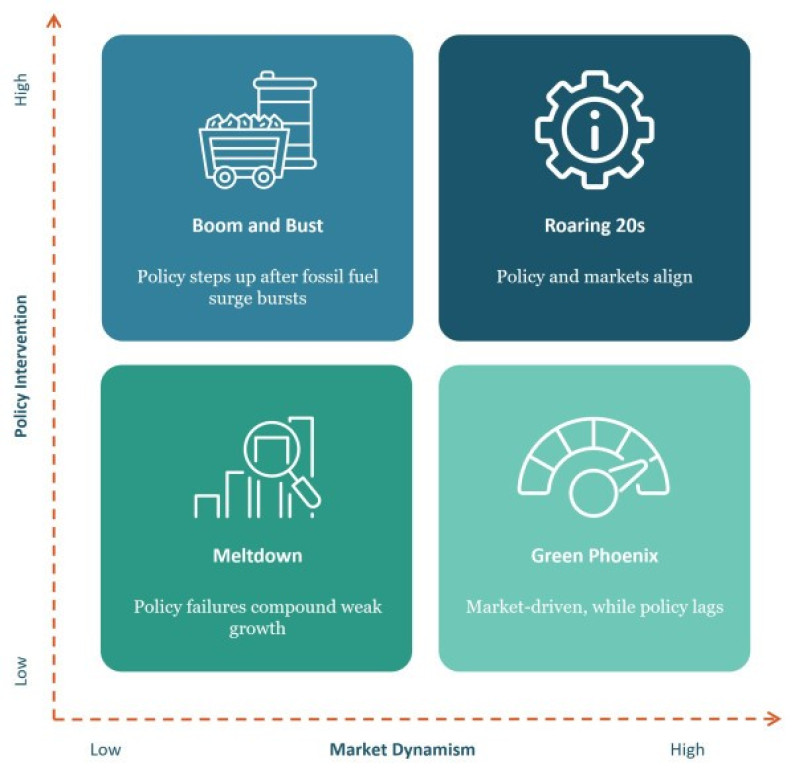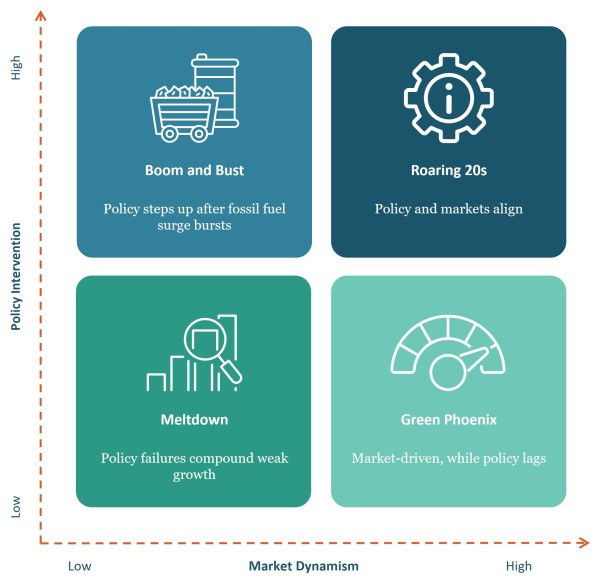No Time To Lose scenarios
The ‘No Time To Lose’ global climate scenario narratives focus on short- to medium-term time horizons.
The ‘No Time To Lose’ global climate scenario narratives focus on short- to medium-term time horizons.
Driving forces (also known as ‘drivers’) are typically broad scale factors that influence the direction of future change. Understanding which driving forces will have the greatest influence on outcomes for your focal question is an essential step to creating climate scenarios.
Read more about the drivers used in the No Time To Lose scenarios on page 41 of the scenarios report.
The No Time To Lose scenarios, published in September 2023, are a collaboration between the Universities Superannuation Scheme in the UK and the University of Exeter.
The narrative global scenarios depict the world through four different lenses:
The No Time To Lose scenarios were designed in response to calls from policymakers and regulators for short-term scenarios (compared to the typical long-term ‘100-year’ scenarios).
The need to address shorter time horizons is an important shift in applying climate scenarios because it switches the focus away from long-term climate trends to the shorter-term fluctuations of politics, markets, and extreme weather events.
The matrix of scenarios includes four varying combinations of high or low policy activism and high or low market dynamism.
The No Time To Lose scenarios are especially relevant to transition planning and financial decision-making, with an emphasis on the potential impact on macroeconomic variables and asset markets in the short-term.
The No Time To Lose Scenarios highlight implications for investment portfolios and strategic asset allocation and risk management.
Some public sector entities may find the scenarios (or elements of the scenarios) useful for testing policies or exploring possible future with a focus on the short term.
The No Time To Lose scenarios were created to provide climate scenarios with a short-term focus. Before using these scenarios, consider if your policy test or focal question of interest would benefit from a short-term focus (up to 2030).
In most scenario archetypes, physical risks are relatively minor before 2030. Therefore, using scenarios with longer time-horizons (eg,. 2070 or 2100) may be necessary to avoid missing some key considerations.
The No Time To Lose scenarios are based on the IPCC’s SSP2 Middle of the Road narrative.
Limitations of the IPCC’s SSP scenarios include:
Read more about limitations of the IPCC scenarios
For more on the limitations of existing climate scenarios, see The Emperor's new climate scenarios from the University of Exeter [Institute and Faculty of Actuaries website].
There are four No Time To Lose scenarios, each with a different narrative and emissions trajectory.

Read the description of the graph below.

Read the description of the graph below.
This scenario is outlined by the shift towards dynamic markets that create powerful positive feedback loops, allowing for proactive climate policies and markets to align.
More extreme weather events focus minds and create a sense of global solidarity around a recognition of humanity’s mounting debt to nature. Investment from public and private sectors fast roll-out of green infrastructure and technology and accelerates innovation.
Technological progress and deployment are accelerated by:
With regards to energy and asset prices:
The Green Phoenix scenario depicts a world where popular anger builds and civil society gradually emboldens more enlightened businesses and local governments to step up and roll out mature green technologies, but progress is patchy and erratic.
The shift is market-driven while policy lags. Climate action is initially upended by stagflation, the geo-political fallout of a stalemate in Ukraine, and poorly handled weather shocks. Downturn-fueled nationalism prevents cooperation.
Activist ESG investors and consumer pressures drive ‘greening,’ leading to further asset stranding.
A V-shaped pattern of growth encompasses:
This scenario sets out a pathway where easing of global geopolitical tension triggers an initial surge in economic growth. This leads to overheating in major economies and higher fossil fuel prices. Policy is tightened in response leading to a bust and forcing governments to step in to provide support.
Following the Boom and Bust bursts, global cooperation is reinforced and a recovery stimulus drives green investment.
A just green transition is driven by pro-active policies to ease private sector frictions and support the emerging world.
The meltdown scenario depicts a world where:
Extreme weather events are badly handled which triggers famines, mass migration, and political instability.
An energy trade war keeps fossil fuel prices volatile and asset stranding hurts the financial system. Amidst weak investment, nationalist governments support home fossil fuel industries and renewables to achieve ‘energy security’.